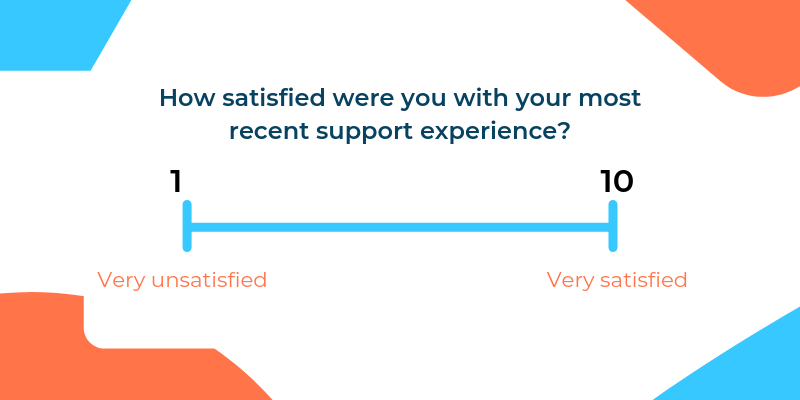Platform
Call Center
Get Started
Wanna subscribe to our blog?
Get updates once a month.
Platform
Call Center
Solutions
Get Started
Wanna subscribe to our blog?
We'll send you updates once a month.
Wanna subscribe to our blog?
Get updates once a month.
Wanna subscribe to our blog?
We'll send you updates once a month.

Customer experience isn't new. While the "CX" label is relatively fresh, the idea of creating positive brand impressions at every opportunity is something that customer-centric companies have subscribed to for a while.
Today, the difference is that more companies are looking to measure how effective their CX initiatives are. Customer experience metrics give businesses real insights into how their online presence, products, and support experiences are perceived by the outside world - and how that impacts their bottom line. While there's no shortage of ways to measure customer interactions, I wanted to lay out 4 higher-level metrics that can be especially telling.
Before we do that, let's quickly recap what customer experience is, and why companies should make it a priority.
Put simply, customer experience refers to the way customers perceive your brand, starting with the very first time they interact with you. While great support and customer success initiatives are a big piece of the puzzle, memorable CX starts at the beginning of the buyer journey.
The goal is to create a consistent and positive experience through every interaction and touchpoint (social media, website, email etc). Companies that get this right don't just retain more business - they create momentum for their brand by increasing the likelihood that existing customers will vouch for it. Customer experience metrics are designed to help companies understand how their interactions with customers are driving retention, and ultimately revenue.
Now that we're on the same page about what CX is and why it's important, let's talk about how you measure it.
Keep in mind, customer experience metrics can get pretty granular. When you're trying to quantify the impression that your company is leaving on customers, there's no shortage of things you can track. If you want to measure how well your website is being received, you can track how much time visitors are spending on it and how often they're converting into leads. If you're trying to gauge how effective your support interactions are, you can look to metrics like Average Handle Time and First Call Resolution rate.
It's important to keep track of those metrics if you want to understand how each customer touchpoint is performing. However, if your goal is to measure your brand perception as a whole and learn how it's helping or hurting your business, here are 4 higher-level customer experience metrics that you can look to:
By looking at these metrics, you can quickly get a sense for how effective your CX initiatives are - and how they're impacting your business.
This one is straightforward. CSAT scores have been around for a little while, and are popular because of how easy it is for customers to provide them. To calculate CSAT, companies can broadly ask how satisfied customers are with their product/service, or tie the question to specific instances (ex. how would you rate your most recent support experience?) CSAT is calculated on a scale, typically either 1-5 or 1-10. This makes CSAT one of the simplest ways to gauge each customer interaction.

Companies usually have plenty of opportunities to ask for a satisfaction score. The most obvious are the times that customers have a support interaction - think about how often you've received one of those "how'd we do?" emails.
Another great time to ask CSAT questions is after big moments in a customer's journey with your company, usually because the experience is top-of-mind. If you haven't done this already, try asking a new customer to rate their onboarding experience before handing them off to your support team - this can give you some insight into a critical part of their journey and help you ensure that you're starting relationships off on the right foot.
The next key customer experience metric is Customer Effort Score (CES). This one is also useful because of its' simplicity, but it also has a huge impact on companies' ability to retain business. The definition is right in the name - CES measures how much effort customers have to put in to ask questions, get support, or purchase additional services.
Like CSAT, CES surveys also ask customers to rate their experience on a scale. Because the question is related to how easy or difficult it was for a customer to get what they were looking for, the two ends are simply "very easy" and "very difficult."
CES is especially telling when it comes to customer retention. Recent findings show that 96% of customers who have service interactions classified as "high-effort" become more disloyal, as opposed to just 9% who have "low-effort" experiences.
By now, most companies are familiar with the idea that it's much less expensive to retain existing customers than it is to go find new ones. That's what makes churn such an important customer experience metric.
Customer churn simply refers to the percentage of customers that stop paying for or using a product or service. Every company experiences it in some form, and reducing it has become a major priority for two reasons.
The first is that companies are now focused on ways to maximize Customer Lifetime Value (CLV). The reason is simple - retaining customers is inexpensive. For a business to create sustainable growth, it needs to keep acquisition costs low and focus on maximizing the profitability of each customer.
Companies can also take this a step further. One of the main reasons that CX has become such a priority is because a brand's most loyal customers are more likely to help drive new business by sharing their experience with friends, family, and colleagues. Which brings us to the next (and arguably most telling) metric...
NPS measures how likely a customer is to recommend your company to someone else. It's an all-encompassing customer experience metric that accounts for interactions across every stage of the customer journey. Think about it - for you to really advocate for a brand, doesn't your experience with them have to be positive across the board? One well-written marketing email or support experience doesn't create enough enthusiasm for a customer to tell someone else about a company, but every positive interaction builds momentum towards that end goal.
Like the first two metrics mentioned in this post, NPS simply asks customers to rate how likely they would be to recommend a brand on a 1-10 scale. To get actionable insight from responses, customers are split into 3 groups:
The goal for any company that's serious about CX is to create as many "Promoters" as possible. Every CX initiative should be focused on strengthening customer relationships by addressing their needs and building trust. Companies that do this effectively maximize the value of each existing customer, and create a low-cost way to acquire new ones in the process.
These Stories on Customer Experience
No Comments Yet
Let us know what you think